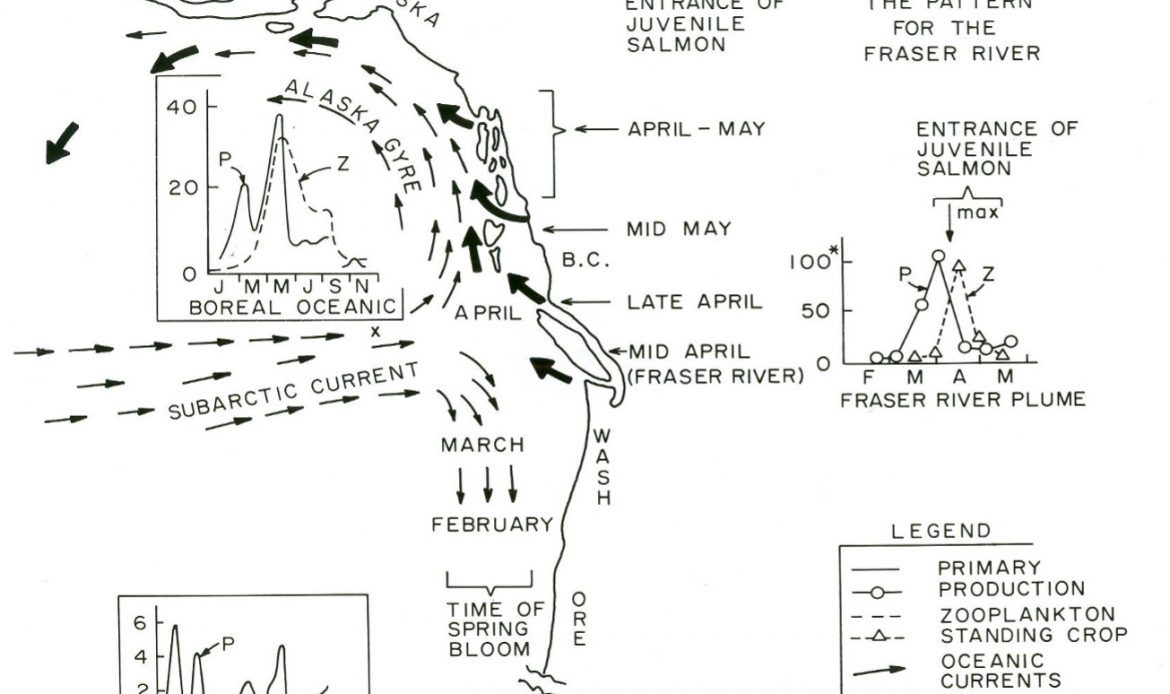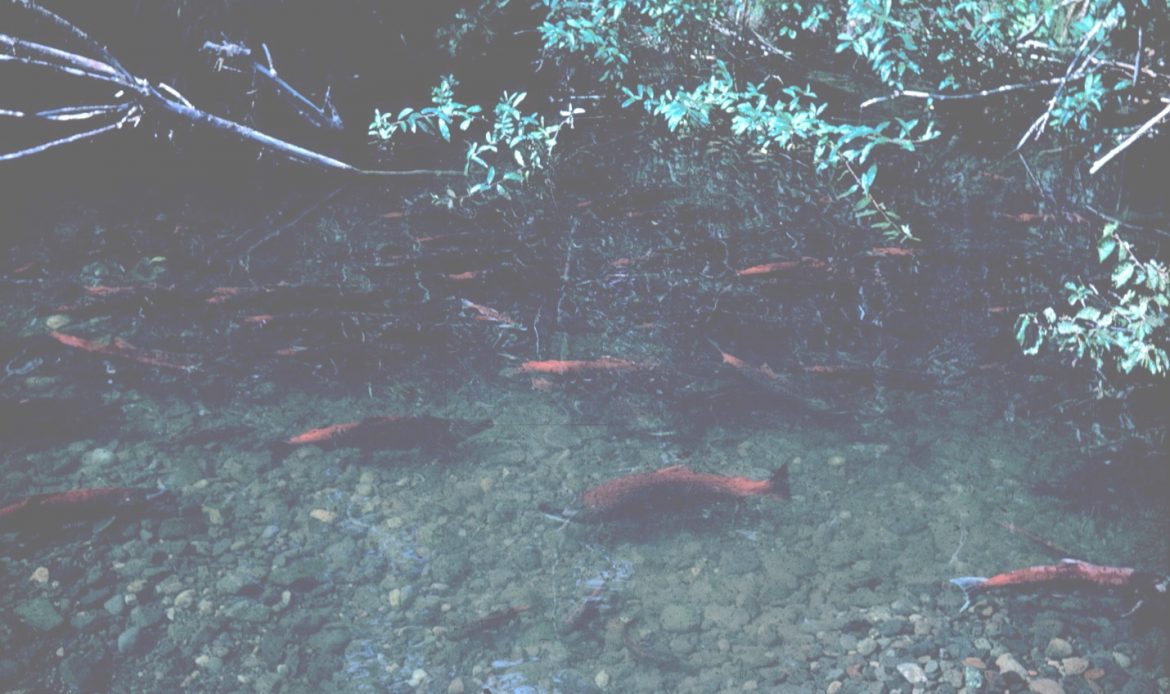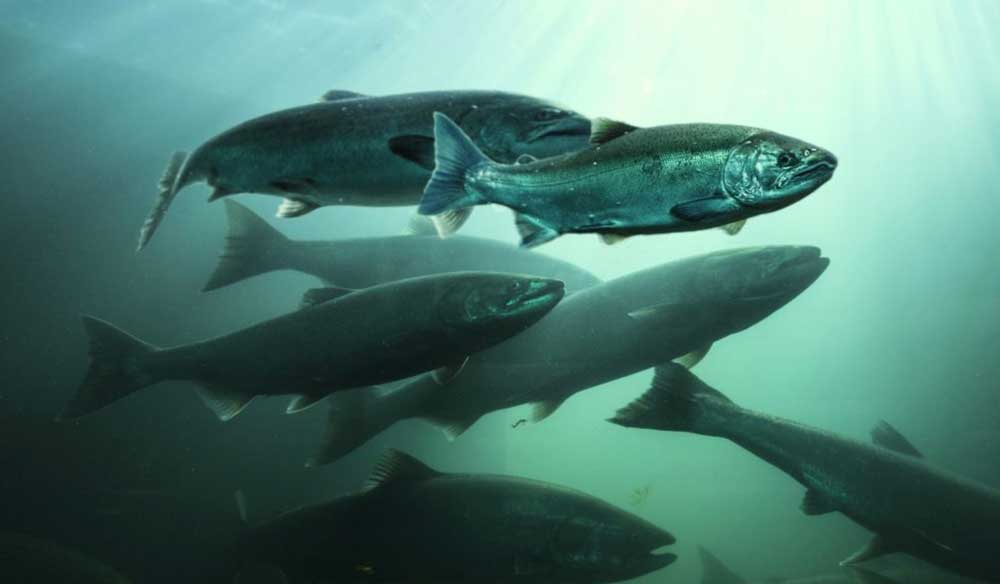Charlie Hall did his Ph.D. work on fish migration in a small, beautiful river in North Carolina under the direction of systems ecologist Dr. Howard Odum.
He spent much of his time interviewing the renowned salmon biologists Dr. Peter Larkin at Nanaimo B. C. and got an opportunity to travel with Dr. David Narver to Babine Lake to see real salmon research. All of these ideas contributed to the development of his ideas on energy return on investment, as seen in his dissertation summary (Hall 1972).
A salmon, like all of life, is under constant selective pressure to ensure that what he or she does returns more Energy than the Energy invested in doing it. Year-old sockeye Salmon travel hundreds or even thousands of miles from where they are born in the Pacific Northwest streams to the sea. They then turn northward, following the spring “bloom” of their food (called plankton) up to Alaska (see figure 2 below). In the summer, they turn westward along the Aleutian Islands and south again in the mid-Pacific Ocean during the fall. They then move North again the next year, and they may cycle with the seasons for several additional years before returning to and ascending their natal streams, spawning and dying. These migrations are obviously extremely energy-intensive, but we know they return more Energy to the salmon than the energy cost because those salmon that do migrate are about four times larger. The females contain four times as many eggs as a few of their brothers and sisters that do not (called kokanee). In other words, the salmon thought to have originated in freshwater, evolved the complicated process of long migrations to and through the ocean because that energy investment helped them find more food, and hence enhanced their fitness (their ability to generate offspring) through straight-forward Darwinian processes. Likewise, successful human exploitation of Nature’s energy sources, be it sunlight or oil, is most useful when the Energy returned is high relative to that invested. These ideas are summarized in the concept of EROI, or Energy Returned on Investment, which is a critically important idea as we examine our energy future. It is fundamental to what we do at the BioPhysical Economics Institute.
In his later years, Charlie has returned to studying salmon, working with Jim Brown and others to examine in more detail the evolutionary implications of size, life history, and energy return on investment.

Figure 1. Representation of the life history of Sockeye salmon. The salmon are born in the interior of (especially) British Columbia and Alaska, spend a year in lakes, and then go to the ocean at about the time of maximum availability of their food, which is strongly seasonal. They then turn northward, following the bloom of plankton, then westward. In the fall they swim south and then cycle again the next year. At about their fourth year, they return to their natal streams and, if not eaten by a bear, spawn and continue the cycle.

Figure 2. Sockeye salmon waiting for final maturity to spawn in Pierre Creek, B.C. The larger salmon have been to the sea. The smaller salmon (called kokanee, visible in foreground) are their brothers and sisters who did not migrate. Thus migration allows the exploitation of a larger and presumably denser food resource. The energy returned from migration is obviously much greater than that invested (as represented by their larger size). The larger salmon have about four times more eggs than those that did not, giving a straightforward Darwinian selection for migration. (Picture by Charles Hall)
Literature:
- Hall, C.A.S. 1972. Migration and metabolism in a temperate stream ecosystem. Ecology 53 (4): 585-604. (Ph.D. Thesis, University of North Carolina, Chapel Hill, 1970).
- Hall, C.A.S. 2017. Energy Return on Investment: A unifying principle for Biology, Economics, and sustainability. SpringerNature N.Y.
Brown, James H., Charles A.S. Hall and Richard M. Sibly. 2018. Energy and Fitness: all species are equally fit. Nature Ecology and Evolution: Vol. 2: February: 262–268. - Hall, C.A.S., F. Knickmeyer,3 A. Wiegman, A. Brainard, A. R. Diaz, C. Huynh, and J. Mead. (2018) A class exercise for systems ecology: synthesis of stream energetics and testing Allen’s paradox. Ecological Modeling. Ecological Modelling 369: 42–65.
- Burger, Joseph R., Chen Hou, Charles A.S Hall, and James H. Brown. Metabolic life tables: the sockeye salmon example. Submitted.
- Burger, Robert, Chen Hou, Charles A.S Hall, James H. Brown. (in press). Universal rules of life: metabolic rates, biological times, and the equal fitness paradigm.


